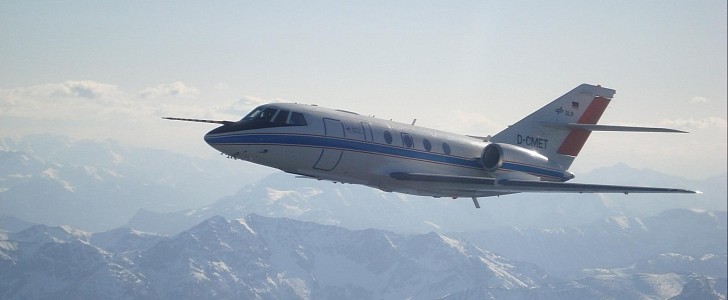Although the aviation industry is already implementing environmentally friendly alternatives, ranging from sustainable aviation fuel (SAF) to innovative hydrogen fuel cell systems and hybrid or fully-electric propulsion systems, extensive research on how these new solutions impact the environment is still required.
Two well-known names in the industry, Airbus and the German Aerospace Center (DLR), have signed a new agreement for expanding their joint research on climate protection in aviation. DLR’s Falcon 20-E research aircraft and an Airbus test aircraft have already worked side by side, conducting measurement flights.
These flights were carried out within the Emission and Climate Impact of Alternative Fuels (ECLIF3) campaign. This ongoing study is meant to measure the emissions of aircraft using 100% SAF, and compare them to emission levels associated with conventional kerosene. Although current regulations only allow aircraft to run on 50% SAF, things are about to change in the near future, and this type of research will help accelerate the transition towards clean fuels.
Their future collaboration will focus particularly on determining hydrogen’s impact on the environment, through emission measurements. Another part of the future joint project is establishing climate models, which means to model the climate impact of air traffic, by using the adequate design innovations to create aircraft that are climate-optimized.
“The more precise atmospheric and climate models are, the better we can use them as a basis for developing and optimizing aircraft,” said Nicole Dreyer-Langlet, Airbus' VP Research & Technology Representative.
DLR’s Falcon 20-E (D-CMET) is one of the most important European flying research platforms, in use for over 40 years. The modified aircraft, which is undergoing regular upgrades, in order to adapt to the continuous changes in scientific research, has been primarily used in atmospheric projects.
Able to fly higher than most airliners (at 42,000 feet/12,800 meters), this airborne laboratory can reach the lower stratosphere, at mid-latitudes. Plus, it’s robust enough to carry out measurements even close to thunderstorms, or at just 98 feet (30 meters) behind the engines of an airliner.
These flights were carried out within the Emission and Climate Impact of Alternative Fuels (ECLIF3) campaign. This ongoing study is meant to measure the emissions of aircraft using 100% SAF, and compare them to emission levels associated with conventional kerosene. Although current regulations only allow aircraft to run on 50% SAF, things are about to change in the near future, and this type of research will help accelerate the transition towards clean fuels.
Their future collaboration will focus particularly on determining hydrogen’s impact on the environment, through emission measurements. Another part of the future joint project is establishing climate models, which means to model the climate impact of air traffic, by using the adequate design innovations to create aircraft that are climate-optimized.
“The more precise atmospheric and climate models are, the better we can use them as a basis for developing and optimizing aircraft,” said Nicole Dreyer-Langlet, Airbus' VP Research & Technology Representative.
DLR’s Falcon 20-E (D-CMET) is one of the most important European flying research platforms, in use for over 40 years. The modified aircraft, which is undergoing regular upgrades, in order to adapt to the continuous changes in scientific research, has been primarily used in atmospheric projects.
Able to fly higher than most airliners (at 42,000 feet/12,800 meters), this airborne laboratory can reach the lower stratosphere, at mid-latitudes. Plus, it’s robust enough to carry out measurements even close to thunderstorms, or at just 98 feet (30 meters) behind the engines of an airliner.







